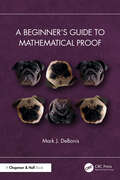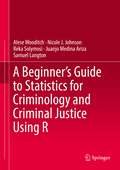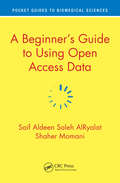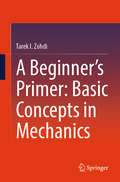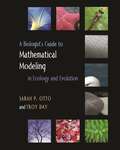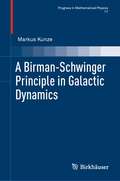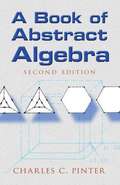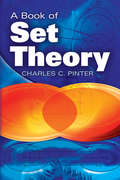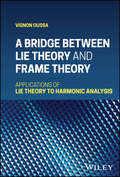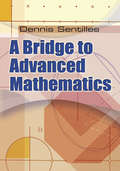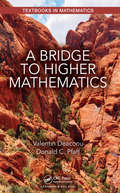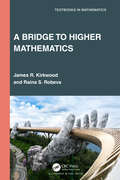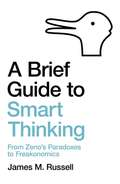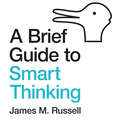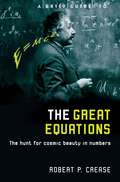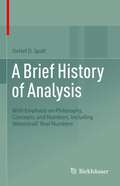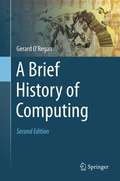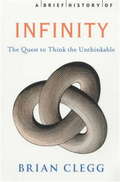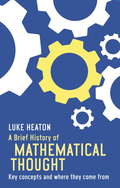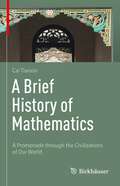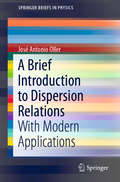- Table View
- List View
A Beginner’s Guide to Mathematical Proof
by Mark J. DeBonisA Beginner’s Guide to Mathematical Proof prepares mathematics majors for the transition to abstract mathematics, as well as introducing a wider readership of quantitative science students, such as engineers, to the mathematical structures underlying more applied topics. The text is designed to be easily utilized by both instructor and student, with an accessible, step-by-step approach requiring minimal mathematical prerequisites. The book builds towards more complex ideas as it progresses but never makes assumptions of the reader beyond the material already covered.Features No mathematical prerequisites beyond high school mathematics Suitable for an Introduction to Proofs course for mathematics majors and other students of quantitative sciences, such as engineering Replete with exercises and examples
A Beginner’s Guide to Statistics for Criminology and Criminal Justice Using R
by Alese Wooditch Nicole J. Johnson Reka Solymosi Juanjo Medina Ariza Samuel LangtonThis book provides hands-on guidance for researchers and practitioners in criminal justice and criminology to perform statistical analyses and data visualization in the free and open-source software R. It offers a step-by-step guide for beginners to become familiar with the RStudio platform and tidyverse set of packages. This volume will help users master the fundamentals of the R programming language, providing tutorials in each chapter that lay out research questions and hypotheses centering around a real criminal justice dataset, such as data from the National Survey on Drug Use and Health, National Crime Victimization Survey, Youth Risk Behavior Surveillance System, The Monitoring the Future Study, and The National Youth Survey. Users will also learn how to manipulate common sources of agency data, such as calls-for-service (CFS) data. The end of each chapter includes exercises that reinforce the R tutorial examples, designed to help master the software as well as to provide practice on statistical concepts, data analysis, and interpretation of results. The text can be used as a stand-alone guide to learning R or it can be used as a companion guide to an introductory statistics textbook, such as Basic Statistics in Criminal Justice (2020).
A Beginner’s Guide to Using Open Access Data (Pocket Guides to Biomedical Sciences)
by Saif Aldeen AlRyalat Shaher MomaniOpen Access Data is emerging as a source for cutting edge scholarship. This concise book provides guidance from generating a research idea to publishing results. Both young researchers and well-established scholars can use this book to upgrade their skills with respect to emerging data sources, analysis, and even post-publishing promotion. At the end of each chapter, a tutorial simulates a real example, allowing readers to apply what they learned about accessing open data, and analyzing this data to reach the results. This book can be of use by established researchers analyzing data, publishing, and actively promoting ongoing and research. Key selling features: Describes the steps, from A-Z, for doing open data research Includes interactive tutorials following each chapter Provides guidelines for readers so that they can use their own accessed open data Reviews recent software and websites promoting and enabling open data research Supplements websites which update recent open data sources
A Beginner’s Primer: Basic Concepts in Mechanics
by Tarek I. ZohdiAs we enter an exciting new era in industrial design, simulation, and manufacturing, a clear understanding of mechanics of solids is needed now more than ever. This primer is a condensed synopsis of basic undergraduate mechanics and is designed to supplement classical textbooks in this area. The focus is on the essentials of mechanics, specifically: • The concept of stress. • Stress-strain relationships. • Failure theory. • Axial loading of a rod. • Transverse (bending) loading of a beam. • Industrial application: modeling of 3D printing. • Transverse shear stresses. • Torsional loading of a rod. • Pressure vessels. • Buckling of columns. • The basics of finite element methods. • A unifying concept: continuum mechanics.
A Biologist's Guide to Mathematical Modeling in Ecology and Evolution
by Troy Day Sarah P. OttoThirty years ago, biologists could get by with a rudimentary grasp of mathematics and modeling. Not so today. In seeking to answer fundamental questions about how biological systems function and change over time, the modern biologist is as likely to rely on sophisticated mathematical and computer-based models as traditional fieldwork. In this book, Sarah Otto and Troy Day provide biology students with the tools necessary to both interpret models and to build their own. The book starts at an elementary level of mathematical modeling, assuming that the reader has had high school mathematics and first-year calculus. Otto and Day then gradually build in depth and complexity, from classic models in ecology and evolution to more intricate class-structured and probabilistic models. The authors provide primers with instructive exercises to introduce readers to the more advanced subjects of linear algebra and probability theory. Through examples, they describe how models have been used to understand such topics as the spread of HIV, chaos, the age structure of a country, speciation, and extinction. Ecologists and evolutionary biologists today need enough mathematical training to be able to assess the power and limits of biological models and to develop theories and models themselves. This innovative book will be an indispensable guide to the world of mathematical models for the next generation of biologists. A how-to guide for developing new mathematical models in biology Provides step-by-step recipes for constructing and analyzing models Interesting biological applications Explores classical models in ecology and evolution Questions at the end of every chapter Primers cover important mathematical topics Exercises with answers Appendixes summarize useful rules Labs and advanced material available
A Biostatistics Toolbox for Data Analysis
by Steve SelvinThis sophisticated package of statistical methods is for advanced master's (MPH) and PhD students in public health and epidemiology who are involved in the analysis of data. It makes the link from statistical theory to data analysis, focusing on the methods and data types most common in public health and related fields. Like most toolboxes, the statistical tools in this book are organized into sections with similar objectives. Unlike most toolboxes, however, these tools are accompanied by complete instructions, explanations, detailed examples, and advice on relevant issues and potential pitfalls - conveying skills, intuition, and experience. The only prerequisite is a first-year statistics course and familiarity with a computing package such as R, Stata, SPSS, or SAS. Though the book is not tied to a particular computing language, its figures and analyses were all created using R. Relevant R code, data sets, and links to public data sets are available from www. cambridge. org/9781107113084.
A Birman-Schwinger Principle in Galactic Dynamics (Progress in Mathematical Physics #77)
by Markus KunzeThis monograph develops an innovative approach that utilizes the Birman-Schwinger principle from quantum mechanics to investigate stability properties of steady state solutions in galactic dynamics. The opening chapters lay the framework for the main result through detailed treatments of nonrelativistic galactic dynamics and the Vlasov-Poisson system, the Antonov stability estimate, and the period function $T_1$. Then, as the main application, the Birman-Schwinger type principle is used to characterize in which cases the “best constant” in the Antonov stability estimate is attained. The final two chapters consider the relation to the Guo-Lin operator and invariance properties for the Vlasov-Poisson system, respectively. Several appendices are also included that cover necessary background material, such as spherically symmetric models, action-angle variables, relevant function spaces and operators, and some aspects of Kato-Rellich perturbation theory. A Birman-Schwinger Principle in Galactic Dynamics will be of interest to researchers in galactic dynamics, kinetic theory, and various aspects of quantum mechanics, as well as those in related areas of mathematical physics and applied mathematics.
A Book Of Abstract Algebra
by Charles PinterAccessible but rigorous, this outstanding text encompasses all of the topics covered by a typical course in elementary abstract algebra. Its easy-to-read treatment offers an intuitive approach, featuring informal discussions followed by thematically arranged exercises. Intended for undergraduate courses in abstract algebra, it is suitable for junior- and senior-level math majors and future math teachers. This second edition features additional exercises to improve student familiarity with applications. <p><p> An introductory chapter traces concepts of abstract algebra from their historical roots. Succeeding chapters avoid the conventional format of definition-theorem-proof-corollary-example; instead, they take the form of a discussion with students, focusing on explanations and offering motivation. Each chapter rests upon a central theme, usually a specific application or use. The author provides elementary background as needed and discusses standard topics in their usual order. He introduces many advanced and peripheral subjects in the plentiful exercises, which are accompanied by ample instruction and commentary and offer a wide range of experiences to students at different levels of ability.
A Book of Set Theory
by Charles C PinterSuitable for upper-level undergraduates, this accessible approach to set theory poses rigorous but simple arguments. Each definition is accompanied by commentary that motivates and explains new concepts. Starting with a repetition of the familiar arguments of elementary set theory, the level of abstract thinking gradually rises for a progressive increase in complexity.A historical introduction presents a brief account of the growth of set theory, with special emphasis on problems that led to the development of the various systems of axiomatic set theory. Subsequent chapters explore classes and sets, functions, relations, partially ordered classes, and the axiom of choice. Other subjects include natural and cardinal numbers, finite and infinite sets, the arithmetic of ordinal numbers, transfinite recursion, and selected topics in the theory of ordinals and cardinals. This updated edition features new material by author Charles C. Pinter.
A Bridge Between Lie Theory and Frame Theory: Applications of Lie Theory to Harmonic Analysis
by Vignon OussaComprehensive textbook examining meaningful connections between the subjects of Lie theory, differential geometry, and signal analysis A Bridge Between Lie Theory and Frame Theory serves as a bridge between the areas of Lie theory, differential geometry, and frame theory, illustrating applications in the context of signal analysis with concrete examples and images. The first part of the book gives an in-depth, comprehensive, and self-contained exposition of differential geometry, Lie theory, representation theory, and frame theory. The second part of the book uses the theories established in the early part of the text to characterize a class of representations of Lie groups, which can be discretized to construct frames and other basis-like systems. For instance, Lie groups with frames of translates, sampling, and interpolation spaces on Lie groups are characterized. A Bridge Between Lie Theory and Frame Theory includes discussion on: Novel constructions of frames possessing additional desired features such as boundedness, compact support, continuity, fast decay, and smoothness, motivated by applications in signal analysisNecessary technical tools required to study the discretization problem of representations at a deep levelOngoing dynamic research problems in frame theory, wavelet theory, time frequency analysis, and other related branches of harmonic analysis A Bridge Between Lie Theory and Frame Theory is an essential learning resource for graduate students, applied mathematicians, and scientists who are looking for a rigorous and complete introduction to the covered subjects.
A Bridge to Advanced Mathematics
by Dennis SentillesThis helpful "bridge" book offers students the foundations they need to understand advanced mathematics, spanning the gap between practically oriented and theoretically orientated courses. Part 1 provides the most basic tools, examples, and motivation for the manner, method, and material of higher mathematics. Part 2 covers sets, relations, functions, infinite sets, and mathematical proofs and reasoning. 1975 edition.
A Bridge to Higher Mathematics (Textbooks in Mathematics #43)
by Donald C. Pfaff Valentin DeaconuA Bridge to Higher Mathematics is more than simply another book to aid the transition to advanced mathematics. The authors intend to assist students in developing a deeper understanding of mathematics and mathematical thought. The only way to understand mathematics is by doing mathematics. The reader will learn the language of axioms and theorems and will write convincing and cogent proofs using quantifiers. Students will solve many puzzles and encounter some mysteries and challenging problems. The emphasis is on proof. To progress towards mathematical maturity, it is necessary to be trained in two aspects: the ability to read and understand a proof and the ability to write a proof. The journey begins with elements of logic and techniques of proof, then with elementary set theory, relations and functions. Peano axioms for positive integers and for natural numbers follow, in particular mathematical and other forms of induction. Next is the construction of integers including some elementary number theory. The notions of finite and infinite sets, cardinality of counting techniques and combinatorics illustrate more techniques of proof. For more advanced readers, the text concludes with sets of rational numbers, the set of reals and the set of complex numbers. Topics, like Zorn’s lemma and the axiom of choice are included. More challenging problems are marked with a star. All these materials are optional, depending on the instructor and the goals of the course.
A Bridge to Higher Mathematics (Textbooks in Mathematics)
by James R. Kirkwood Raina S. RobevaThe goal of this unique text is to provide an “experience” that would facilitate a better transition for mathematics majors to the advanced proof-based courses required for their major.If you feel like you love mathematics but hate proofs, this book is for you. The change from example-based courses such as Introductory Calculus to the proof-based courses in the major is often abrupt, and some students are left with the unpleasant feeling that a subject they loved has turned into material they find hard to understand.The book exposes students and readers to some fundamental content and essential methods of constructing mathematical proofs in the context of four main courses required for the mathematics major – probability, linear algebra, real analysis, and abstract algebra.Following an optional foundational chapter on background material, four short chapters, each focusing on a particular course, provide a slow-paced but rigorous introduction. Students get a preview of the discipline, its focus, language, mathematical objects of interest, and methods of proof commonly used in the field. The organization of the book helps to focus on the specific methods of proof and main ideas that will be emphasized in each of the courses.The text may also be used as a review tool at the end of each course and for readers who want to learn the language and scope of the broad disciplines of linear algebra, abstract algebra, real analysis, and probability, before transitioning to these courses.
A Brief Guide to Smart Thinking: From Zeno's Paradoxes to Freakonomics
by James M. RussellEach book is summarised to convey a brief idea of what each one has to offer the interested reader, while a 'Speed Read' for each book delivers a quick sense of what each book is like to read and a highly compressed summary of the main points of the book in question. The titles covered include thought-provoking classics on psychology, mindfulness, rationality, the brain, mathematical and economic thought and practical philosophy. The selection includes books about self-improvement as well as historically interesting accounts of how the mind works. Titles included go back as far as the Epictetus classic TheEnchiridion and Bertrand Russell's charming TheABC of Relativity, and proceed through classics such as Edward de Bono's Lateral Thinking and into the digital era with titles such as The Shallows and Big Data. The books are arranged chronologically, which draws attention to some of the interesting juxtapositions and connections between them. Some of the titles included are: Freakonomics, by Steven D. Levitt; Blink: The Power of Thinking Without Thinking, by Malcolm Gladwell; Sapiens: A Brief History of Humankind, by Yuval Noah Harari; The Organized Mind: Thinking Straight in the Age of Information Overload, by Daniel J. Levitin; The Descent of Man, by Grayson Perry; How the Mind Works, by Steven Pinker; Black Box Thinking: Why Some People Never Learn from Their Mistakes - But Some Do, by Matthew Syed; We Should All Be Feminists, by Chimamanda Ngozi Adichie; Guns, Germs, and Steel: The Fates of Human Societies, by Jared Diamond; The Black Swan: The Impact of the Highly Improbable, by Nassim Nicholas Taleb; Man's Search for Meaning, by Viktor E. Frankl; The News: A User's Manual, by Alain de Botton; Mindware: Tools for Smart Thinking, by Richard E. Nisbett; The ABC of Relativity, by Bertrand Russell; The Psychopath Test, by Jon Ronson; The Path: What Chinese Philosophers Can Teach Us About the Good Life, by Michael Puett; A Brief History of Time, by Stephen Hawking; Messy: The Power of Disorder to Transform Our Lives, by Tim Harford; Big Data: A Revolution That Will Transform How We Live, Work, and Think, by Viktor Mayer-Schönberger; Moneyball: The Art of Winning an Unfair Game, by Michael Lewis; The Survivors Club: The Secrets and Science That Could Save Your Life, by Ben Sherwood; Black Box Thinking, by Matthew Syed; Chaos: Making a New Science, by James Gleick; A Short History of Nearly Everything, by Bill Bryson; The Shallows: What the Internet Is Doing to Our Brains, by Nicholas Carr; Making Ideas Happen: Overcoming the Obstacles Between Vision and Reality, by Scott Belsky; The Enchiridion, by Epictetus; Gödel, Escher, Bach, by Douglas R. Hofstadter; What I Talk About When I Talk About Running, by Haruki Murakami; and Lateral Thinking, by Edward de Bono.
A Brief Guide to Smart Thinking: From Zeno's Paradoxes to Freakonomics
by James M. RussellEach book is summarised to convey a brief idea of what each one has to offer the interested reader, while a 'Speed Read' for each book delivers a quick sense of what each book is like to read and a highly compressed summary of the main points of the book in question. The titles covered include thought-provoking classics on psychology, mindfulness, rationality, the brain, mathematical and economic thought and practical philosophy. The selection includes books about self-improvement as well as historically interesting accounts of how the mind works. Titles included go back as far as the Epictetus classic The Enchiridion and Bertrand Russell's charming The ABC of Relativity, and proceed through classics such as Edward de Bono's Lateral Thinking and into the digital era with titles such as The Shallows and Big Data. The books are arranged chronologically, which draws attention to some of the interesting juxtapositions and connections between them. Some of the titles included are: Freakonomics, by Steven D. Levitt; Blink: The Power of Thinking Without Thinking, by Malcolm Gladwell; Sapiens: A Brief History of Humankind, by Yuval Noah Harari; The Organized Mind: Thinking Straight in the Age of Information Overload, by Daniel J. Levitin; The Descent of Man, by Grayson Perry; How the Mind Works, by Steven Pinker; Black Box Thinking: Why Some People Never Learn from Their Mistakes - But Some Do, by Matthew Syed; We Should All Be Feminists, by Chimamanda Ngozi Adichie; Guns, Germs, and Steel: The Fates of Human Societies, by Jared Diamond; The Black Swan: The Impact of the Highly Improbable, by Nassim Nicholas Taleb; Man's Search for Meaning, by Viktor E. Frankl; The News: A User's Manual, by Alain de Botton; Mindware: Tools for Smart Thinking, by Richard E. Nisbett; The ABC of Relativity, by Bertrand Russell; The Psychopath Test, by Jon Ronson; The Path: What Chinese Philosophers Can Teach Us About the Good Life, by Michael Puett; A Brief History of Time, by Stephen Hawking; Messy: The Power of Disorder to Transform Our Lives, by Tim Harford; Big Data: A Revolution That Will Transform How We Live, Work, and Think, by Viktor Mayer-Schönberger; Moneyball: The Art of Winning an Unfair Game, by Michael Lewis; The Survivors Club: The Secrets and Science That Could Save Your Life, by Ben Sherwood; Black Box Thinking, by Matthew Syed; Chaos: Making a New Science, by James Gleick; A Short History of Nearly Everything, by Bill Bryson; The Shallows: What the Internet Is Doing to Our Brains, by Nicholas Carr; Making Ideas Happen: Overcoming the Obstacles Between Vision and Reality, by Scott Belsky; The Enchiridion, by Epictetus; Gödel, Escher, Bach, by Douglas R. Hofstadter; What I Talk About When I Talk About Running, by Haruki Murakami; and Lateral Thinking, by Edward de Bono.
A Brief Guide to Smart Thinking: From Zeno’s Paradoxes to Freakonomics
by James M. RussellEach book is summarised to convey a brief idea of what each one has to offer the interested reader, while a 'Speed Read' for each book delivers a quick sense of what each book is like to read and a highly compressed summary of the main points of the book in question. The titles covered include thought-provoking classics on psychology, mindfulness, rationality, the brain, mathematical and economic thought and practical philosophy. The selection includes books about self-improvement as well as historically interesting accounts of how the mind works. Titles included go back as far as the Epictetus classic The Enchiridion and Bertrand Russell's charming The ABC of Relativity, and proceed through classics such as Edward de Bono's Lateral Thinking and into the digital era with titles such as The Shallows and Big Data. The books are arranged chronologically, which draws attention to some of the interesting juxtapositions and connections between them. Some of the titles included are: Freakonomics, by Steven D. Levitt; Blink: The Power of Thinking Without Thinking, by Malcolm Gladwell; Sapiens: A Brief History of Humankind, by Yuval Noah Harari; The Organized Mind: Thinking Straight in the Age of Information Overload, by Daniel J. Levitin; The Descent of Man, by Grayson Perry; How the Mind Works, by Steven Pinker; Black Box Thinking: Why Some People Never Learn from Their Mistakes - But Some Do, by Matthew Syed; We Should All Be Feminists, by Chimamanda Ngozi Adichie; Guns, Germs, and Steel: The Fates of Human Societies, by Jared Diamond; The Black Swan: The Impact of the Highly Improbable, by Nassim Nicholas Taleb; Man's Search for Meaning, by Viktor E. Frankl; The News: A User's Manual, by Alain de Botton; Mindware: Tools for Smart Thinking, by Richard E. Nisbett; The ABC of Relativity, by Bertrand Russell; The Psychopath Test, by Jon Ronson; The Path: What Chinese Philosophers Can Teach Us About the Good Life, by Michael Puett; A Brief History of Time, by Stephen Hawking; Messy: The Power of Disorder to Transform Our Lives, by Tim Harford; Big Data: A Revolution That Will Transform How We Live, Work, and Think, by Viktor Mayer-Schönberger; Moneyball: The Art of Winning an Unfair Game, by Michael Lewis; The Survivors Club: The Secrets and Science That Could Save Your Life, by Ben Sherwood; Black Box Thinking, by Matthew Syed; Chaos: Making a New Science, by James Gleick; A Short History of Nearly Everything, by Bill Bryson; The Shallows: What the Internet Is Doing to Our Brains, by Nicholas Carr; Making Ideas Happen: Overcoming the Obstacles Between Vision and Reality, by Scott Belsky; The Enchiridion, by Epictetus; Gödel, Escher, Bach, by Douglas R. Hofstadter; What I Talk About When I Talk About Running, by Haruki Murakami; and Lateral Thinking, by Edward de Bono.
A Brief Guide to the Great Equations: The Hunt for Cosmic Beauty in Numbers (Brief Histories)
by Robert CreaseHere are the stories of the ten most popular equations of all time as voted for by readers of Physics World, including - accessibly described here for the first time - the favourite equation of all, Euler's equation.Each is an equation that captures with beautiful simplicity what can only be described clumsily in words. Euler's equation [eip + 1 = 0] was described by respondents as 'the most profound mathematic statement ever written', 'uncanny and sublime', 'filled with cosmic beauty' and 'mind-blowing'. Collectively these equations also amount to the world's most concise and reliable body of knowledge.Many scientists and those with a mathematical bent have a soft spot for equations. This book explains both why these ten equations are so beautiful and significant, and the human stories behind them.
A Brief History of Analysis: With Emphasis on Philosophy, Concepts, and Numbers, Including Weierstraß' Real Numbers
by Detlef D. SpaltThis book explores the origins of mathematical analysis in an accessible, clear, and precise manner. Concepts such as function, continuity, and convergence are presented with a unique historical point of view. In part, this is accomplished by investigating the impact of and connections between famous figures, like Newton, Leibniz, Johann Bernoulli, Euler, and more. Of particular note is the treatment of Karl Weierstraß, whose concept of real numbers has been frequently overlooked until now. By providing such a broad yet detailed survey, this book examines how analysis was formed, how it has changed over time, and how it continues to evolve today. A Brief History of Analysis will appeal to a wide audience of students, instructors, and researchers who are interested in discovering new historical perspectives on otherwise familiar mathematical ideas.
A Brief History of Computing
by Gerard O'ReganThis lively and fascinating text traces the key developments in computation - from 3000 B.C. to the present day - in an easy-to-follow and concise manner. Topics and features: ideal for self-study, offering many pedagogical features such as chapter-opening key topics, chapter introductions and summaries, exercises, and a glossary; presents detailed information on major figures in computing, such as Boole, Babbage, Shannon, Turing, Zuse and Von Neumann; reviews the history of software engineering and of programming languages, including syntax and semantics; discusses the progress of artificial intelligence, with extension to such key disciplines as philosophy, psychology, linguistics, neural networks and cybernetics; examines the impact on society of the introduction of the personal computer, the World Wide Web, and the development of mobile phone technology; follows the evolution of a number of major technology companies, including IBM, Microsoft and Apple.
A Brief History of Infinity: The Quest to Think the Unthinkable
by Brian Clegg'Space is big. Really big. You just won't believe how vastly, hugely, mind-bogglingly big it is. I mean, you may think it's a long way down the street to the chemist, but that's just peanuts to space.' Douglas Adams, Hitch-hiker's Guide to the GalaxyWe human beings have trouble with infinity - yet infinity is a surprisingly human subject. Philosophers and mathematicians have gone mad contemplating its nature and complexity - yet it is a concept routinely used by schoolchildren. Exploring the infinite is a journey into paradox. Here is a quantity that turns arithmetic on its head, making it feasible that 1 = 0. Here is a concept that enables us to cram as many extra guests as we like into an already full hotel. Most bizarrely of all, it is quite easy to show that there must be something bigger than infinity - when it surely should be the biggest thing that could possibly be. Brian Clegg takes us on a fascinating tour of that borderland between the extremely large and the ultimate that takes us from Archimedes, counting the grains of sand that would fill the universe, to the latest theories on the physical reality of the infinite. Full of unexpected delights, whether St Augustine contemplating the nature of creation, Newton and Leibniz battling over ownership of calculus, or Cantor struggling to publicise his vision of the transfinite, infinity's fascination is in the way it brings together the everyday and the extraordinary, prosaic daily life and the esoteric.Whether your interest in infinity is mathematical, philosophical, spiritual or just plain curious, this accessible book offers a stimulating and entertaining read.
A Brief History of Infinity: The Quest to Think the Unthinkable (Brief Histories)
by Brian Clegg'Space is big. Really big. You just won't believe how vastly, hugely, mind-bogglingly big it is. I mean, you may think it's a long way down the street to the chemist, but that's just peanuts to space.' Douglas Adams, Hitch-hiker's Guide to the GalaxyWe human beings have trouble with infinity - yet infinity is a surprisingly human subject. Philosophers and mathematicians have gone mad contemplating its nature and complexity - yet it is a concept routinely used by schoolchildren. Exploring the infinite is a journey into paradox. Here is a quantity that turns arithmetic on its head, making it feasible that 1 = 0. Here is a concept that enables us to cram as many extra guests as we like into an already full hotel. Most bizarrely of all, it is quite easy to show that there must be something bigger than infinity - when it surely should be the biggest thing that could possibly be. Brian Clegg takes us on a fascinating tour of that borderland between the extremely large and the ultimate that takes us from Archimedes, counting the grains of sand that would fill the universe, to the latest theories on the physical reality of the infinite. Full of unexpected delights, whether St Augustine contemplating the nature of creation, Newton and Leibniz battling over ownership of calculus, or Cantor struggling to publicise his vision of the transfinite, infinity's fascination is in the way it brings together the everyday and the extraordinary, prosaic daily life and the esoteric.Whether your interest in infinity is mathematical, philosophical, spiritual or just plain curious, this accessible book offers a stimulating and entertaining read.
A Brief History of Mathematical Thought: Key concepts and where they come from
by Luke HeatonMathematics is a product of human culture which has developed along with our attempts to comprehend the world around us. In A Brief History of Mathematical Thought, Luke Heaton explores how the language of mathematics has evolved over time, enabling new technologies and shaping the way people think. From stone-age rituals to algebra, calculus, and the concept of computation, Heaton shows the enormous influence of mathematics on science, philosophy and the broader human story.The book traces the fascinating history of mathematical practice, focusing on the impact of key conceptual innovations. Its structure of thirteen chapters split between four sections is dictated by a combination of historical and thematic considerations. In the first section, Heaton illuminates the fundamental concept of number. He begins with a speculative and rhetorical account of prehistoric rituals, before describing the practice of mathematics in Ancient Egypt, Babylon and Greece. He then examines the relationship between counting and the continuum of measurement, and explains how the rise of algebra has dramatically transformed our world. In the second section, he explores the origins of calculus and the conceptual shift that accompanied the birth of non-Euclidean geometries. In the third section, he examines the concept of the infinite and the fundamentals of formal logic. Finally, in section four, he considers the limits of formal proof, and the critical role of mathematics in our ongoing attempts to comprehend the world around us. The story of mathematics is fascinating in its own right, but Heaton does more than simply outline a history of mathematical ideas. More importantly, he shows clearly how the history and philosophy of maths provides an invaluable perspective on human nature.
A Brief History of Mathematical Thought: Key concepts and where they come from (Brief Histories)
by Luke HeatonMathematics is a product of human culture which has developed along with our attempts to comprehend the world around us. In A Brief History of Mathematical Thought, Luke Heaton explores how the language of mathematics has evolved over time, enabling new technologies and shaping the way people think. From stone-age rituals to algebra, calculus, and the concept of computation, Heaton shows the enormous influence of mathematics on science, philosophy and the broader human story.The book traces the fascinating history of mathematical practice, focusing on the impact of key conceptual innovations. Its structure of thirteen chapters split between four sections is dictated by a combination of historical and thematic considerations. In the first section, Heaton illuminates the fundamental concept of number. He begins with a speculative and rhetorical account of prehistoric rituals, before describing the practice of mathematics in Ancient Egypt, Babylon and Greece. He then examines the relationship between counting and the continuum of measurement, and explains how the rise of algebra has dramatically transformed our world. In the second section, he explores the origins of calculus and the conceptual shift that accompanied the birth of non-Euclidean geometries. In the third section, he examines the concept of the infinite and the fundamentals of formal logic. Finally, in section four, he considers the limits of formal proof, and the critical role of mathematics in our ongoing attempts to comprehend the world around us. The story of mathematics is fascinating in its own right, but Heaton does more than simply outline a history of mathematical ideas. More importantly, he shows clearly how the history and philosophy of maths provides an invaluable perspective on human nature.
A Brief History of Mathematics: A Promenade through the Civilizations of Our World
by Tianxin CaiThis volume, originally published in China and translated into four other languages, presents a fascinating and unique account of the history of mathematics, divided into eight chronologically organized chapters. Tracing the development of mathematics across disparate regions and peoples, with particular emphasis on the relationship between mathematics and civilization, it examines mathematical sources and inspirations leading from Egypt, Babylon and ancient Greece and expanding to include Chinese, Indian and Arabic mathematics, the European Renaissance and the French revolution up through the Nineteenth and Twentieth Centuries. Each chapter explores connections among mathematics and cultural elements of the time and place treated, accompanying the reader in a varied and exciting journey through human civilizations. The book contemplates the intersections of mathematics with other disciplines, including the relationship between modern mathematics and modern art, and the resulting applications, with the aid of images and photographs, often taken by the author, which further enhance the enjoyment for the reader. Written for a general audience, this book will be of interest to anyone who's studied mathematics in university or even high school, while also benefiting researchers in mathematics and the humanities.
A Brief Introduction to Dispersion Relations: With Modern Applications (SpringerBriefs in Physics)
by José Antonio OllerThis text offers a brief introduction to the dispersion relations as an approach to calculate S-matrix elements, a formalism that allows one to take advantage of the analytical structure of scattering amplitudes following the basic principles of unitarity and causality.First, the case of two-body scattering is considered and then its contribution to other processes through final-state interactions is discussed. For two-body scattering amplitudes, the general expression for a partial-wave amplitude is derived in the approximation where the crossed channel dynamics is neglected. This is taken as the starting point for many interesting nonperturbative applications, both in the light and heavy quark sector. Subsequently crossed channel dynamics is introduced within the equations for calculating the partial-wave amplitudes. Some applications based on methods that treat crossed-channel dynamics perturbatively are discussed too.The last part of this introductory treatment is dedicated to the further impact of scattering amplitudes on a variety of processes through final-state interactions. Several possible approaches are discussed such as the Muskhelishvili-Omnes dispersive integral equations and other closed formulae. These different formalisms are then applied in particular to the study of resonances presenting a number of challenging properties. The book ends with a chapter illustrating the use of dispersion relations in the nuclear medium for the evaluation of the energy density in nuclear matter.
